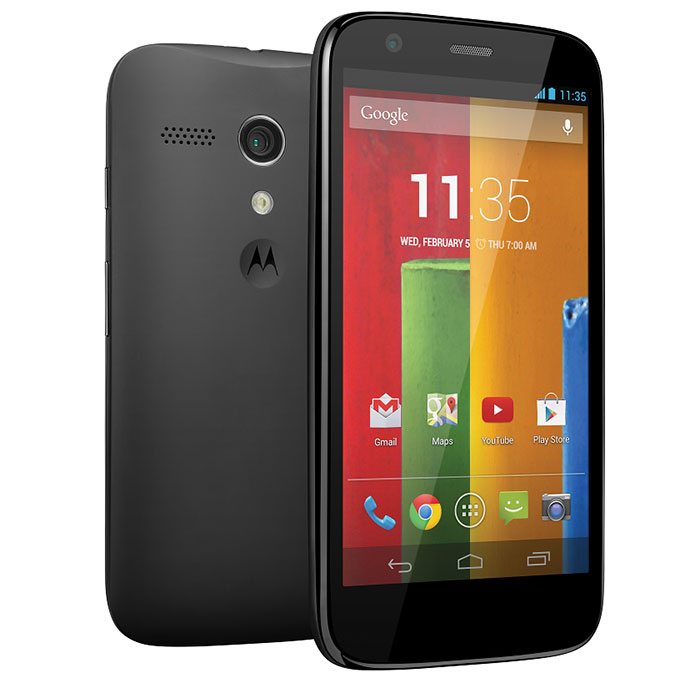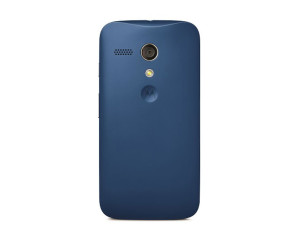Motorola is pushing strong in its global smartphone revival with the keenly priced Moto G handset. A mid-range handset with a low-end price tag and Android KitKat.
In terms of design the Moto G takes most of its cues from the firm’s first, post-Google takeover handset, the Moto X.
It’s hardly groundbreaking in terms of looks, but the soft, curved edges of the Moto G make it relatively attractive and the swath of plastic feels solid and well built.
Weighing in at 143g the Moto G has a pleasing, well balanced presence in the hand without being overbearing, and while it may measure 11.6mm thick in the middle the tapered edges make it feel thinner than it is.
Couple that with a rubberized rear plate which slightly hugs the side of the handset too, and the Motorola Moto G fits comfortably in the palm, providing a decent level of grip.
The Moto G features a water repellent coating which means you’ll be able to whip it out in the rain without fear of a short circuit, but it is not waterproof – so no jumping in the pool with it.
You can even take the rear cover off and swap it for a different color, which Motorola is pushing as a big customizable feature of the phone. In reality however it just reminds me of my Nokia 3310.
Sure, changing covers is fun for all of five minutes, but the novelty soon wears off. Not to mention the back cover is also pretty tricky to remove – you need to really dig your nails in at the base of the handset to get it free.
In fact, so much strength needs to be employed to free the cover from the Moto G I feared on more than one occasion that the thin plastic would snap – thankfully it never did.
Motorola did make a point that the younger generation like the ability to “customize” their handsets and this particular feature, along with the rock bottom price, reinforces the Moto G’s credentials as a handset which may land in the laps of many teenagers.
The left side of the Motorola Moto G is devoid of any features, while the top of the handset only sports a centralized headphone jack. Both the power/lock key and volume rocker switch are located on the right of the G and these are easy to reach and responsive to the press.
On the base is a microUSB port, while under the removable cover is a microSIM port – but no microSD slot. That means if you want to expand the onboard storage you’ll have to take to the cloud.
The 2070mAh non-removable battery housed inside the Moto G is claimed to give you all day battery life, and I put that to the test – skip ahead to the battery life and connectivity section to see how it got on.
The Moto G comes with a 4.5-inch, 1280 x 720 display and boasts a 329ppi pixel density. To put that in some perspective that’s a bigger, higher resolution and more defined display than the iPhone 5S – but for a third of the price.
Of course a HD display isn’t the only key factor in a smartphone, but Motorola has managed to equip the Moto G with a 1.2GHz quad-core Snapdragon 400 processor and 1GB of RAM.
In terms of specs then the Motorola Moto G is actually giving the HTC One Mini, Samsung Galaxy S4 Mini and Nokia Lumia 820 a run for their mid-range, dual-core money – and once again the screen is bigger than these rivals. The Motorola handset even beats the Samsung and Nokia when it comes to resolution
The camera on the rear of the Moto G is only 5MP and this is trumped by the S4 Mini and Lumia 820 and their 8MP snappers.
All in all the Moto G finds itself in no-mans land, with a complete disconnect between its price and spec list. This, of course, isn’t a bad thing and on paper it offers outstanding value for money.
The proof however, is in the pudding, so let’s see how the Moto G got on in real life.
INTERFACE
The Motorola Moto G is one of the first handsets to be updated to Google’s latest software – Android 4.4.2 KitKat..
With a 1.2GHz quad-core processor and 1GB of RAM at its heart, the Moto G is more than well equipped enough to run KitKat which is the smoothest version of Android to date.
Android purists will be pleased to learn that the Moto G is running the stock version of KitKat, with Motorola opting against applying an overlay – claiming instead that it’s focused on things which add real benefit to users.
These “benefits” include a faster boot up time and improved audio, data management, web speeds and general navigation.
I found that the Moto G did boot up impressively quickly, but Motorola’s claims that it performs various tasks quicker than the Samsung Galaxy S4 still seem a little far fetched to me.
Sure the interface is smooth – impressively so in fact when you consider the price – but I can’t say that it noticeably out performs, or even matches the various flagships I’ve had the pleasure of using.
General operation is fluid and while it may not be as lightening quick as the top end handsets, the quad-core chip is doing a good job under the hood and I had no issues with lag.
You get five homescreens – no more, no less (there’s no way to add or remove) – and the familiar Android set up with a selection of widgets available in the tabbed app drawer for you to choose from.
Drag and drop an app onto another on any homescreen and the Motorola Moto G will automatically create a folder with both applications inside, allowing you to easily organize and manage your favorite apps.
The pull down notification bar at the top of the Moto G’s display offers up a feast of information from recent calls, new emails and text messages to Google Now prompts, app updates and third party notifications.
Glide a finger over certain notifications, such as a new email alert, and it will expand allowing you to see a longer overview of the message.
Slide you finger up from the home key at the base of the screen and you’ll launch Google Now, Android’s own digital personal assistant and Siri rival.
Google Now offers up relevant information in a series of cards, and by tracking your movement, messages and emails it can tailor these cards to suit your needs.
You can get information such as the weather, meeting reminders and details on the journey home here. It’s still relatively hit and miss and there are far fewer features enabled for those outside of the US, but Google is constantly working on Now and it’s slowly becoming more relevant.
Tap the multi-tasking key in the bottom navigation bar and you’ll be greeted with the familiar stack of thumbnails showing the apps which are currently running.
This is testament to the quad-core processor inside the Moto G, as the handset can comfortably handle multiple apps at the same time and you’re able to switch between them very quickly.
Basic applications opened promptly, but I did notice some lag with some of the more demanding games, such as Stick Cricket and Stick Tennis.
When these were tapped the Motorola Moto G took a couple of seconds to load up the application. It’s not a huge issue and game play is still smooth once you’re past the initial load, but it just hints at a potentially small flaw in the low 1.2GHz clock speed of the quad-core chip.
Everything looks bright, crisp and clear on the 4.5-inch display and while the Moto G doesn’t match up to the full HD offerings you get on the flagship phones, for a handset with such a low price you’ll be more than happy and it puts the competition to shame.
There’s a thin bezel down each side of the screen, but it’s not the slimmest I’ve seen and I reckon Motorola is pushing its luck a little calling it an “edge-to-edge display.”
Sure it doesn’t feel like there’s any unnecessary plastic padding around the screen, but it’s not a close cut as on other handsets – the LG G2 springs to mind immediately as a handset with a slimmer bezel.
The screen is also very responsive to the touch which makes moving around the Moto G a stress-free experience.
CAMERA/VIDEO
While many of the specs on the Moto G have exceeded its price, the camera is an area where Motorola has clearly tried to save some money.
On the rear of the handset you’ll find a 5MP camera and single LED flash, while on the front you get a 1.3MP snapper.
Motorola has done some work in the camera app on the Moto G, providing a minimalist interface which sees all the settings hidden from view and the whole screen made into a shutter key.
Now I’ve bemoaned the use of the whole screen as the shutter on other handsets, as the fiddly little app icons could be easily missed, leading to me taking many unwanted snaps.
Luckily this issue has been overcome on the Motorola Moto G, as the settings wheel is accessed by sliding your finger from left to right over the display – not once did I accidentally take a picture when trying to tweak options.
That might be partly due to the fact I rarely found myself accessing settings, because it’s seriously slim pickings.
For anyone looking to tinker with various modes, effects and advanced settings such as brightness and white balance the Moto G is not the camera-phone for you.
All you get are flash, HDR mode, shutter sound and aspect ratio toggles along with a Panorama mode, the ability to attach location information to your snaps and a rudimentary focus & exposure control.
Shutter speed is pretty swift, but if you fancy a burst mode just hold down on the screen and the Moto G will snap away until you release your finger.
There’s a 4x digital zoom to boot which is controlled by sliding your finger up and down the display – although picture quality takes a serious battering, so it’s best avoided.
The full screen trigger makes snapping photos easy as you don’t have to aim for a small shutter button on screen, although once you see the results you may wish you never bothered.
That budget price tag really rings true here, and I found the majority of my photos were a pixelated mess. The Motorola Moto G struggled to focus properly and even with the focus & exposure setting turned on things didn’t improve.
The Moto G performed better close up, as it was obvious what to focus on – but when looking at landscapes and situations with a lot going on it just couldn’t make up its mind.
It’s a real shame that the Moto G doesn’t have even a slightly better camera offering, but at its rock bottom price point a concession had to be made somewhere, and this is it.
If you’ve already read the camera section of this Moto G review then your expectations for video recording on the handset are probably pretty low.
And so they should be, as that 5MP sensor is also responsible for the 720p video capture on the Moto G.
Options were sparse for the camera function, and there’s even less choice on offer when it comes to video recording.
Hit the video recorder icon in the camera app and the Moto G will start recording straight away – no change of mode and no new wheel of settings, just straight into the action.
That’s great if you’re in a hurry to start recording, but it also means you get the same limited settings wheel as the camera app, with some of the features obviously not compatible with the video recorder.
One option which is dedicated to filming is slow motion capture, allowing you to add a rather simple, yet pleasing effect to your videos. It’s not as impressive as the implementation on the iPhone 5S, but nether the less it’s a nice feature to have.
Resulting footage is acceptable when played back on the Moto G’s 4.5-inch display, but it doesn’t look great when moved to a larger screen such as a computer or TV.
BATTERY LIFE & CONNECTIVITY
Motorola claims that the 2070mAh non-removable battery inside the Moto G will give you all day battery life, and while I found it’s unlikely to see out 24 hours, it’s just about able to see through the day.
I managed to get a full days use from the Moto G and by the time I got into bed the battery meter in the notification bar was red and the handset was in need of an overnight charge.
The Moto G had been used pretty heavily, with a couple of hours of music streaming, web surfing, constantly updating email inboxes, some social media activity and a few hours of pretty intense gaming.
With more reserved usage the Moto G will comfortably make it to bedtime, last overnight and give you a few hours use in the morning (if you’re lucky). If you’re planning on staying overnight somewhere you’ll still need to take your charger with you to be safe.
It’s worth keeping an eye on screen brightness, especially when you’re watching movies on the Moto G as it can drain the battery somewhat.
That’s not a terrible result, but if you’re planning a bit of a movie marathon you’ll want to make sure you’re within reach of a charger.
If you find yourself getting close to the limit but are nowhere near a charger you can always enable the battery saver which restricts background data activity in an attempt to eek out more life.
The Moto G comes with all the standard connectivity options you’d expect from a low-end smartphone – Wi-Fi, Bluetooth, GPS and 3G are all on board.
Pull down the notification bar on the Moto G, tap the icon in the top corner and you’ll get a selection of quick settings allowing you to toggle Wi-Fi and Bluetooth quickly.
For the other options you’ll need to head into the settings menu, where you’ll also find the wireless hotspot function. This lets you share your phone’s data connection with other devices, such as tablets and laptops.
Keep an eye on your data usage though, as this can munch through it in next to no time and you don’t want to be lumped with a huge bill.
I’ve already talked about the lack of a microSD slot, so more of an importance is placed on the microUSB port on the base of the device as you’ll need to plug the Moto G into a computer to transfer over multiple files.
There’s sadly no 4G support and while this isn’t a surprise when you look at the price tag, it’s still something I’d have liked to see on the Moto G. NFC is also missing, but this is less of an issue as that technology has yet to take off in a big way.








